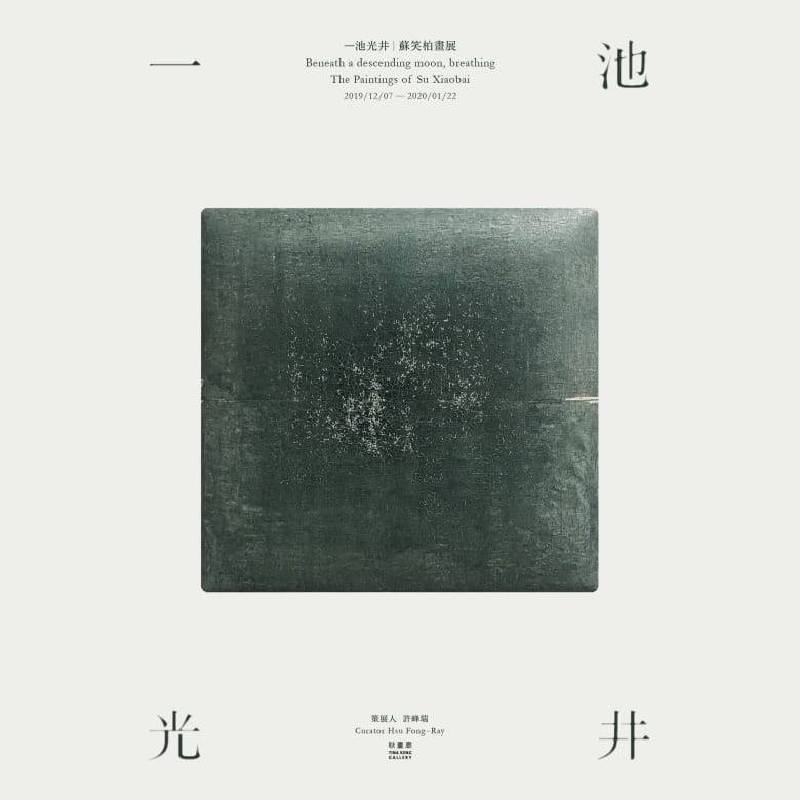耿畫廊
【一池光井蘇笑柏畫展 The Paintings of Su Xiaobai】

-
展期
日期:2019-12-07 ~ 2020-01-22
-
地點
台北市11492內湖區瑞光路548巷15號B1
-
參展藝術家
-
「把故事留給要故事的人,我只要一點光就夠了。」-蘇笑柏
蘇笑柏的故事,蘇笑柏的繪畫,蘇笑柏的大漆,早已填滿在媒體文字中,關於這一切蘇笑柏只用一句「把故事留給要故事的人,我只要一點光就夠了。」便結束了故事。展覽「一池光井」,無意延續故事,也並非命名故事,而是策展對藝術家創作的回應。
522 容貌
在工作室門口,我們拉了兩張椅子重新認識彼此,藝術家說道:「你到畫廊這麼久了,怎麼對你都沒甚麼印象?只是聽著他們提到你,但這次才真正能一起做到展覽。」和多數藝術家和策展人初次討論創作一樣,衝突的火花將時間凝結在膠著的空氣中,直到依賴著日光的工作室漸漸昏暗,模糊到幾乎看不清楚對方的樣貌,此時,我才真正見到這位藝術家。
523 光井
藝術家不喜歡開燈,他的創作幾乎都是在充足的日光下進行。工作室的頂部有個電動遮幕,當它緩緩被拉開,光灑落了一地,映照出作品的形體,亮起畫面的痕跡。藝術家尋尋覓覓的那件作品,每件都一樣,卻又偏偏不一樣。它在陽光陣陣灑落又時明時暗的下午,工作室的光井下隱隱浮現,卻隨著天色漸漸沒入黑暗。是那件作品吧。
524 痕跡
工作室是作品生產的第一案發現場,而我就像幽靈,飄浮在這空間中撿拾事件的痕跡。鐵網片、刻上尺度的直角木板、長約兩呎的自製圓規、串成鏈的滾輪及鐵件,這些沾上斑駁顏料的物件,必定與畫面的痕跡有所關聯。昨晚離開工作室前塗上粉色大漆的畫面,現在表面已半乾,印象中滿滿厚厚一層的顏色,現在卻隱隱透出上漆前微藍的底色。畫面的線索,藏在時間裡;作品的光,藏在痕跡裡。
525 玉石
這個炎熱的下午,我們在後院拎著水管為竹園澆水,原來零零落落地出現在不同工作桌上的石子,是來自這竹園下的雨花石。這讓我想起工作桌前的書籍,關於河姆渡文化、玉器、陶瓷、碑文和《Ikonen》的畫冊,當我看著手上的雨花石,才領悟原來作品中那難以用文字承載的感覺,此刻近在眼前地樸素、簡單。
526 胚
瓦灰和大漆覆蓋前的擠塑板,是作品的起點,也是這次訪行後,展覽的啟點。用它來做展覽的主視覺吧,那一片片手做的展覽邀卡,如同藝術家一層層疊起的顏色,它所堆起的厚度、過程的痕跡和每件看似一樣,卻又偏偏不一樣的作品,在精神上,或許能更靠近一點。然而,它們是不一樣的存在。一個是藝術家的作品,一個是展覽的作品。
策展人|許峰瑞
---
Leave the narrative to whoever wants a narrative. All I ask for is a little light. — Su Xiaobai
We read Su Xiaobai’s stories, admire his paintings and scrutinize his lacquer, all of which have been featured extensively in the media. Yet to him, a single remark serves to conclude these overflowing narratives: “Leave the narrative to whoever wants a narrative. All I ask for is a little light.” The exhibition Beneath a descending moon, breathing: The Paintings of Su Xiaobai has no intention to extend the narrative, or to title it. It is, simply, a curator’s response to the artist’s work.
522 Appearance
At the entrance to his studio, we put two chairs together and tried to get to know each other, as if we were online friends meeting for the very first time. “How is it that I don’t really know much about you, given how long you’ve worked at the gallery,” Su said. “I’ve heard others mention you of course, but this is the first time we’ve actually worked together on an exhibition.” Just like most artists and curators first discuss works, our ideas collided in chemistry, and time seemed to have frozen. We talked and lost all sense of time, until the natural light faded and dusk blanketed the studio. The growing darkness obscured his face, which morphed into a dim silhouette. And it was then that I could finally see the true artist.
523 Light Well
The artist prefers not to have the lights on in his studio, and works only when there is abundant sunlight. There is an electrically controlled curtain installed on the ceiling of his studio, and as it drew open, rays of sunlight spilled onto the ground illuminating his works, highlighting their shapes and textures. The artist was searching for a particular painting among paintings that seemed to both look alike and unalike. There it was — on this afternoon when the studio moved in and out of brilliance, lighted by a fickle sun that sometimes flung its broad beams through the light well or furtively dimmed, throwing the studio into shadows — the painting seemed to emerge under the light well yet slowly descended into darkness as twilight fell. Perhaps that was the one.
524 Traces
The studio is the primary field of discovery of an artist’s production. I am a ghost drifting across the space, picking up the traces of all that has happened here. Pieces of wire mesh, a wooden carpenter’s square, a two-foot-long handmade measuring compass, roller chains, metal pieces. These physical objects mottled in paint must somehow be associated with the marks on the paintings. A canvas coated last night with pastel pink lacquer is now half dry. I remember it as a thick layer of color, but now a light shade of blue that had been applied before the pink discreetly surfaces. The clues of the painting are concealed by time; the light of the painting is concealed within its vestiges.
525 Jade and Stone
On this scorching afternoon, we are watering the bamboos with hoses in the back garden. The small stones I saw scattered on various worktables in the studio turn out to be rain flower pebbles that originally came from this bamboo garden. This reminds me of the books about the Hemudu culture, jade, pottery, stele, and a book titled Ikonen piled on the studio desk. Staring at the rain flower pebbles cupped in my hand, I had an epiphany about the indescribable emotions that are expressed in his work. The inexplicable has been revealed, right in front of my eyes, plain and simple.
526 Embryo
The substrate, before being covered in ash and lacquer, is the starting point of his work and, after this visit, the beginning of an exhibition. Make it the central piece then. The handmade invitation cards echo the way the artist creates colors layer by layer; they seem linked in spirit to his paintings, in the thickness of their layers, in the traces left behind after production, in the way each of them is almost identical but distinctive. One, the work of an artist; the other, the work of an exhibition.
▎About Su Xiaobai
Born in 1949 in Wuhan, China, Su Xiaobai lives and works in Shanghai and Düsseldorf. A graduate from the Düsseldorf Academy of Fine Arts in Germany, and a member of the Association of Dusseldorf Artists 1844 (Verein der Düsseldorfer Künstler 1844), he has developed a visual language rich in personal experience and abstraction under the guidance of Konrad Klapheck, Gerhard Richter, and Markus Lupertz, by breaking away from the skills mastered in Beijing.
Immersion in Western culture and separation from his homeland led Su Xiaobai to rediscover the duality between art and object, and renewed his perspective towards the traditional culture of his ancestry. Su became inspired by lacquer — a thousand-year-old plant material and a symbol of Oriental culture — upon his return to China in 2002. He began experimenting lacquer on linen, bricks, sackcloth, clay, vine, and wood as a substitute for oil on canvas. The artist paints layers of vibrantly colored lacquer in a structural and balanced composition, rendering a three-dimensional momentum. The seemingly arbitrary, yet meticulously deliberate handling of visual forms reveals the artist’s pursuit of aesthetics and his personal sense of reinvention.
Su Xiaobai has exhibited internationally, including And There’s Nothing I Can Do, Hyogo Prefectural Museum of Art, Kobe City, Japan (2018); Grand Immensity-The Art of Xiaobai Su, National Taiwan Museum of Fine Arts, Taichung, Taiwan (2013); The Dynasty of Colours, Langen Foundation, Neuss, Germany (2009); Kao Gong Ji — Xiaobai Su Solo Exhibition, Today Art Museum, Beijing, China (2008); and Intangible Greats, Shanghai Art Museum, Shanghai, China (2007).
Curator|Hsu Fong-Ray

